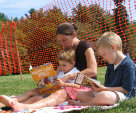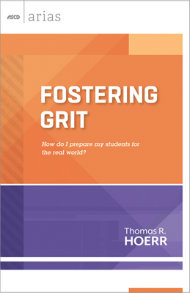Fostering Grit: How do I prepare my students for the real world?
Fostering Grit: How do I prepare my students for the real world?
By Thomas R. Hoerr
(ASCD, 2013 – Learn more)

Failure. Frustration. These are NOT four-letter words.
Tenacity. Perseverance. Resilience. Grit. These are qualities we wish we would see more often in our students.
In an era when adults protect children from failure at all costs and every child gets a trophy, this slim volume (38 pp. plus appendix – part of the new ASCD Arias short book series), gives a clear overview of grit and its importance. Thomas R. Hoerr’s thinking dovetails nicely with Carol Dweck’s work on Growth Mindset, which is why I chose to read it. I was looking for a resource to offer my teachers to support our efforts to shift ourselves and our students to a growth mindset, in which mistakes are opportunities for growth and risk is accepted.

Much of what Hoerr has to say resonates with what I already know. “Responding appropriately when things go wrong—turning a failure into a good failure, one from which we learn—is key to success in life.” He reports that educational research shows how factors like grit can have an impact equal to that of intellectual factors on academic performance and professional achievement.
So far so good.
But where I was looking for some meaty, in-depth advice on teaching grit, Hoerr offers an overview and a sample for a single lesson plan. To foster grit, he says, we must set the right climate in our classrooms, making them places where it is safe to take risks and where failures are viewed as inevitable bumps on the way to ultimate success. We must consider principles of differentiation in our teaching of grit just as we would in teaching any academic skills. Awareness of each child’s frustration threshold is key to helping students stretch just beyond their comfort zone. “The goal is for students to experience frustration so they can learn to respond to it.”
Mostly a conversation starter
This text (aimed primarily at a leadership audience) does offer a teacher survey as well as a student survey to self-reflect on various aspects of grit. The author also provides a number of references to digitally available resources on the importance of perseverance. I liked the table to help students reflect on how hard a task is and to reflect on how they’re feeling. I might add to that a reflection on how much effort students feel they are exerting for various tasks. Students could reflect on their “effort log” just like they would reflect on their reading log to recognize patterns and set goals.
Perhaps the best advice Hoerr offers is to include the whole school community, including parents, in the effort to foster grit. Start a conversation. If you’re in a teaching role, I think this book might be best to share with your administrator if you believe that grit should be a bigger focus in your school-wide improvement plan. It could, perhaps, be shared by an administrator with a team or teacher who could most benefit from considering the role of grit in increasing rigor in their classroom.
This is a timely topic with the increased rigor intended by the Common Core State Standards. Our students will need grit when they sit down to the new generation of assessments, and they will certainly need grit in their lives. But to actually teach grit and help students develop more resilience and persistence, you will need resources beyond this one.
Katie Gordon just completed her first year as an elementary reading consultant and coach, splitting time between building the reading capacity of her students and the teaching capacity of her colleagues. She comes to coaching from 10 years in middle and high school classrooms, during which time she struggled to find the answers for the challenges her own students were facing. Their struggles lead her to read copiously and eventually enroll in a sixth year program in reading.




























